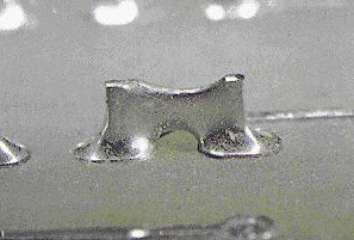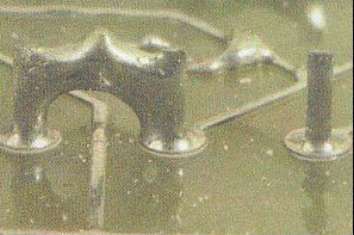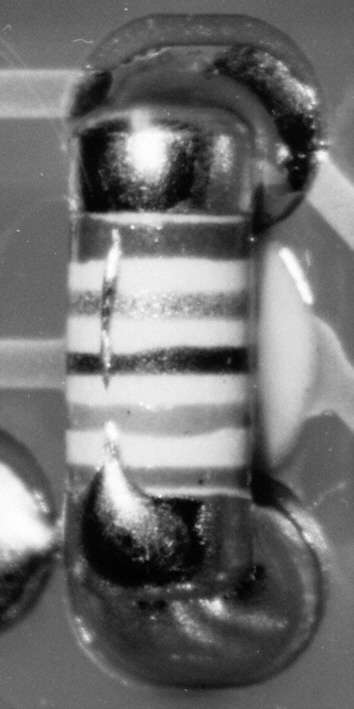For uncovered board surface: solder forming sail between two neighbouring conductors, preferably where conductors change direction. In case of adjacent contact pins (THD): bridging due to polluted solder ( alloy change ).
Sails studs, general
Description:
Solder sail between two contact pins of a THD. Because dross had been moved about unintentionally, the excess solder could not drain correctly during the wave soldering process. This leads to a typical defect: solder sails or (as in this case) solder bridges.
Causes/Remedy:
- polluted solder / alloy change
- unsuitable soldering parameter: soldering time, soldering temperature
- poor wettability of contacts
 Source:
Source:visual, optical inspection - general view
Description:
Solder sail between two THD contacts as well as solder adhering to board surface (background). This defect was also caused by polluted solder. Another aspect is that if a board coating is not compatible with the flux used it can cause the surface to get rough or to burst (this is often the case when the solder resist has not sufficiently hardened)
Causes/Remedy:
- polluted solder / alloy change
- unsuitable soldering parameter: soldering time, soldering temperature
- poor wettability of contacts
- insufficient hardening of laminate/solder resist
- solder resist incompatible with flux
 Source:
Source:visual, optical inspection - general view
Solder sails at MiniMELF
Description:
Solder adhering to a MiniMELF resistor after wave soldering. This defect may be caused by changes in the solder alloy, changes in the component surface as well as incompatibility between component and flux. Reduced wetting of the component contacts can also contribute to this. Correcting the soldering parameter and controlling the composition of the solder is the quickest remedy in most of the cases. In our case (on the left) rework is necessary.
Causes/Remedy:
- polluted solder / alloy change
- unsuitable soldering parameter: soldering time, soldering temperature
- poor wettability of contacts
- insufficient wettability of component
 Source:
Source:visual, optical inspection - general view
Our analytics team can help you find the cause.
go to failure analysis at TechnoLab
